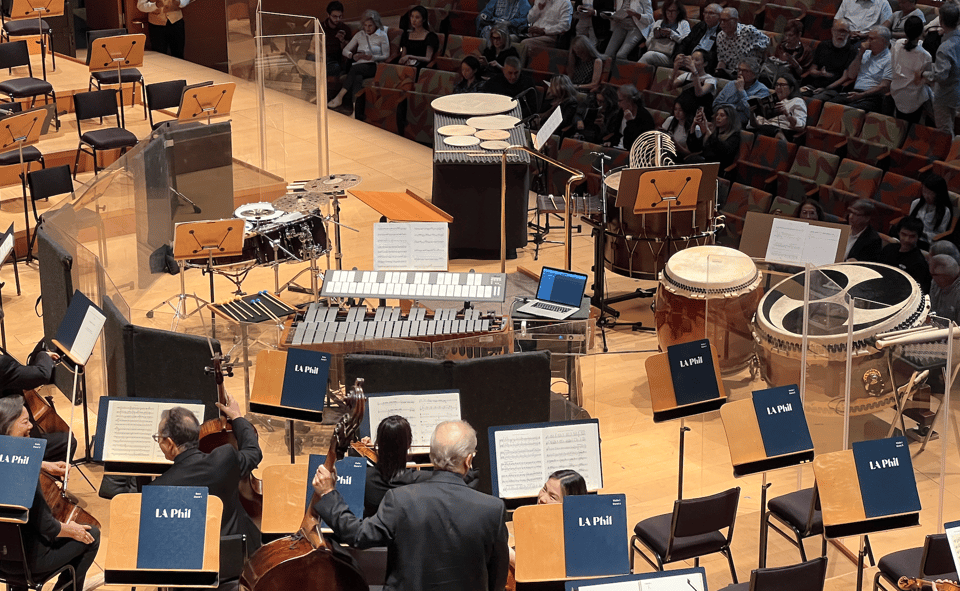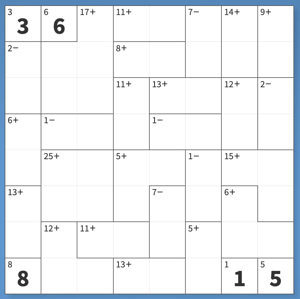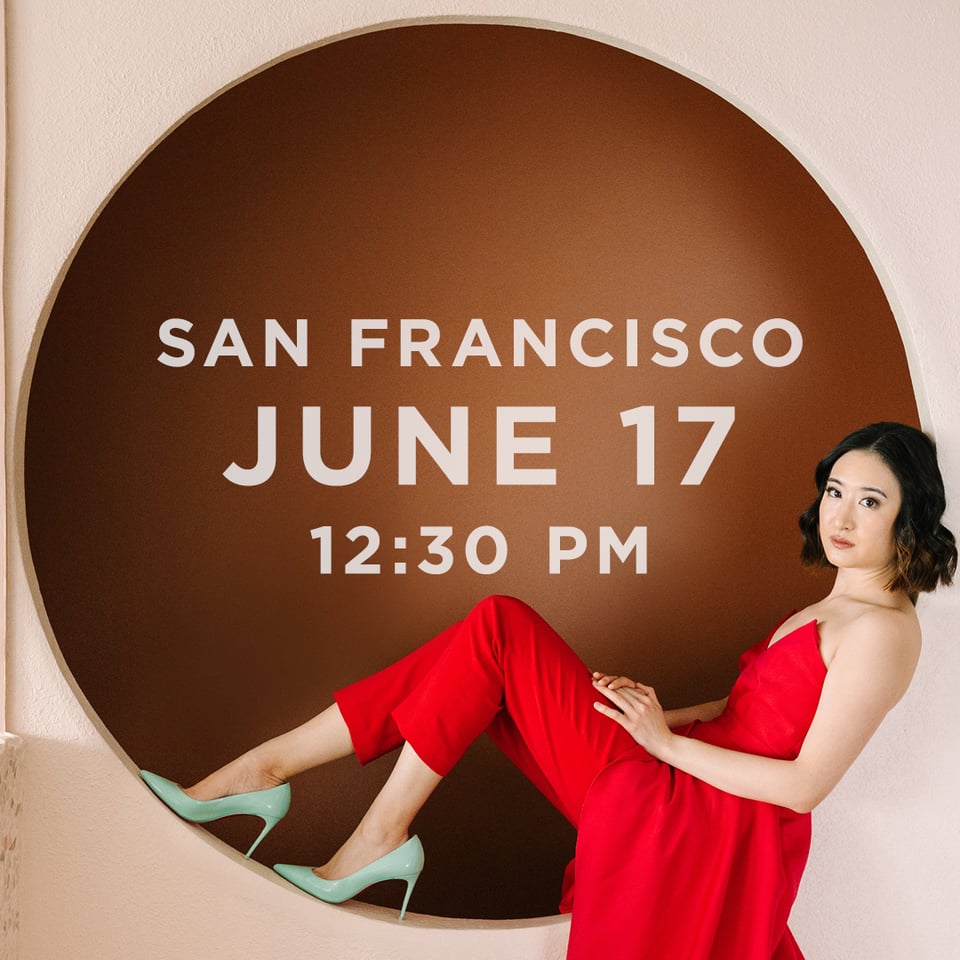Concert reminder, how to buy me on iTunes, and the coolest percussion concerto
Plus the return of Fun Math
I know that I have already mentioned that I’ve got some concerts in the SF Bay Area next week, but just in case you don’t open every single newsletter I write (it’s fine, there are plenty of other people’s newsletters I’m weeks behind on)…hey, I’ve got some concerts in the SF Bay Area next week!
On Tuesday the 17th at 12:30 I’ll be playing on the Noontime Concerts series at Old St. Mary’s Cathedral in San Francisco. It is free.
On Saturday the 21st I’ll be playing a private house concert which I’ve been told is all full so if you’re in the Bay and want to see me, the San Francisco performance is it!
Call me, beep me, if you wanna stream me, if you wanna play me it’s okay
Some people have asked if there’s a way to purchase my latest recording instead of streaming it because you like supporting artists and owning the music you listen to. If this applies to you, congrats, you are my favorite kind of person* and I hope each side of your pillow is always cool.
You can buy the recording on iTunes here if you so desire. It is priced at 99 cents because I do not know how to set a different price.
If any of you have any philosophical objection to purchasing from iTunes, contact me and we can figure something out.
*For those of you unfamiliar with streaming payouts, I pretty much get something between 0 cents and 1 cent per play, depending on which service you’re streaming me on (Youtube and Spotify being the worst). Yeah, it's rough.
Wake up babe, new percussion concerto just dropped
Oh Los Angeles Philharmonic, you spoil me so. You keep commissioning and premiering new works that send me into absolute ecstasies; just off the top of my head, in the last five years alone you’ve delivered a kickin’ electric bass concerto, a harp concerto that blew my mind, the lushest most magical little symphonic work, an electrifying feminist revolution, and an absolutely banging depiction of Hell. You prove that classical music is not even remotely dying and other major American orchestras wish they could be you.
By complete accident I happened to be at the premiere of the Phil’s newest concerto (I had credit that had to be used immediately) and as soon as the piece started I thanked whatever stars had randomly aligned to bring me to the concert hall that day. Joseph Pereira’s percussion concerto, Naru, performed by Matthew Howard, was one of the coolest things I’ve ever seen the LA Phil do. If they don't bring it back for a future season I will riot.

The stage setup for the percussion concerto was absolutely insane. Usually when I see the stage set for a new orchestral work with enough stuff in the percussion section to stock a hardware store, I know I’m in for a piece that’s not going to do much for me, because it’s usually a sign that the composer doesn’t have that tight of a vision and is overly reliant on percussion gimmicks. And I mean that with all the shade it implies.
Not a single piece of onstage percussion in Naru, though, was wasted, and the entire thing was so freaking cool that I regretted being at the last performance of the weekend, because all I wanted to do was immediately buy tickets to see it again.
Howard’s performance was absolutely riveting even before he struck a single note—at the start of the piece he stood solemnly at the enormous taiko drum and, several bars before his solo began, he picked up two enormous sticks, one of which was the size of a baseball bat, and raised them slowly over his head, creating delicious, ominous tension in the hall as we all held our breaths waiting for the drop.
The first strike on the taiko drum was world-ending and the audience's reaction was visceral: a communal gasp rippled through the hall and a man in my section let out a sharp, involuntary “Jesus!”
Howard proceeded to beat the hell out of that taiko but somehow—and don’t ask me how, I’m a finger-wiggling percussionist and not a whack-big-drum percussionist—also coaxed a rainbow of sound out of it, producing different timbres and textures with just the sticks in his hand. The entire concerto turned out to be a showcase of clever virtuosity to that effect: yes, there were dazzling polyrhythms and displays of physical stamina that made my abs and biceps hurt just watching, but the more impressive feat was the expansion of color beyond the palette you usually get from the orchestra.
I think all the time about how, for all the colors we human beings see, there are entire swaths of the light spectrum that are off-limits to us. Many birds, for example, see UV color, and in fact have spectacular colors and patterns on their bodies that you can only see if your eyes pick up UV, which ours don’t. Our visual world has a lot of secret vibrancy that we will simply never see.
Seeing the performance of Naru felt like the auditory version of being granted UV vision. The LA Phil, already capable of a cinematic range of sound and color on any given day, produced—with the help of the maxed-out percussion setup—an expanded rainbow of timbre and texture. The concerto focused less on melody and harmony, what we traditionally think of as the building blocks of beautiful music, and demonstrated that if you know what you’re doing with timbre and rhythm, you can create something astonishing and extremely compelling.
I was reminded of composer (and writer and citizen archaeologist and podcaster) Melissa Dunphy’s excellent essay about Ravel’s Bolero (which the Phil played two weeks previously):
Our tools for analyzing timbre are nowhere near as robust as those for analyzing harmony, at least at the undergraduate level, so less attention is paid to it. Generations of young composers have been convinced by theorists that timbre is less worthy of study than melody and harmony because there exists no equivalent of Roman numeral analysis for timbre, and its application doesn’t adhere to any set of easily teachable rules.
[…]
By removing typical variables like melody and harmony, he makes the orchestration the star and demonstrates how it alone can hold attention, control form, and manipulate the listener’s emotions just as effectively as chromatic harmony and unendliche Melodie.
According to my program, a recording of the concert will be aired on KUSC on June 22, but I genuinely don't believe the magic of the concerto is going to come across via an audio recording when so much of the piece's power comes from its spatial relationship to the listener in the concert hall. (If that first BOOM on the taiko isn't going to send shockwaves through your vital organs, then what's the point?)
A recording also isn't going to convey the sheer coolness of how the piece looked in the hall. One of my favorite moments came when Howard at the front of the stage and a member of the percussion section at the back of the stage played identical rapid figurations at the same time—watching them vibrate in unison across a vast distance brought the sci-fi concept of linked photons to mind. (Physicists, don't @ me.)
Now, I did have two small gripes, not about the worth-the-cost-of-admission concerto, but about the concert itself. My first gripe is that after the splendid finish of one of the most riveting pieces I’ve seen on stage (and the usual intermission), the Phil played Tchaikovsky’s 5th, which was…just okay. I like Tchaik, and there was nothing wrong with the performance at all, but after the ecstasy of Pereira’s percussion concerto, listening to Tchaikovsky made me feel like I’d been kicked out of Narnia and shoved back into the wardrobe.
My second gripe? So to start with, this concert was maybe the most significant hometown affair (complimentary) the Phil has had in a while, imho. The percussion concerto was written by the LA Phil's principal timpanist and performed by its principal percussionist (how special is that?) and then, after intermission, the orchestra's CEO came on stage to announce that longtime concertmaster Martin Chalifour was retiring and that this was his last concert.
 Give this man all the flowers.
Give this man all the flowers.
Chalifour is, for a lot of frequent concertgoers, the enduring face of the LA Phil; he's been principal concertmaster since 1995 and I've lost count of the number of solos and concerto performances I've seen him give in the hall whose architect used him to test its acoustics. His retirement marks the end of an era.
All in all, this was an extremely meaningful performance for the LA Phil. So here is my second gripe: why wasn’t the LA Phil’s own music director there?
The program was conducted by a different Gustavo—Gustavo Gimeno, whose conducting I thoroughly enjoyed—from the one who has come to be synonymous with classical music in LA. Gimeno was such a masterfully graceful conductor that I'd happily see him again, but the presence of a guest conductor at such a meaningful concert had big "substitute teacher at graduation" energy.
Dudamel still has one more season with the LA Phil (source: the deluge of mail I’ve gotten exhorting me to buy tickets to “Gustavo’s last season”) but his absence from a concert with so much local significance made it feel like he’s already over LA. :/
The return of Fun Math
I have previously written about my quiet obsession with Sudoku, which most of the time satisfies the little beaver in my brain that needs to constantly gnaw on logic puzzles. My one tiny complaint about Sudoku is that for a game that uses numbers, there is absolutely no math involved, and sometimes my brain yearns for math the way my muscles yearn for stretchy yoga. (I’ve always been annoyed that NYT Games’ tagline for their daily sudoku puzzle is “A numbers game, minus the math,” as if math is some big scary monster that frightens off the type of people who are drawn to the NYT Games page.)
If you have been reading my newsletter for a while, you may recall that at one point, NYT Games launched a new game called Digits, a game that was just math, and it was the perfect game for me. I was obsessed. I couldn’t start my day without first doing my Fun Math. So of course the NYT, following in their long and hallowed tradition of making questionable decisions, discontinued the game and left a Fun Math void in my life.
Well, last week a friend who is even more of a casual puzzle freak than I am turned me on to Calcudoku, which has changed my life. It takes the logical reasoning from Sudoku and mashes it with basic mental math, and something about that combination makes my brain so, so happy. Fun Math is back, people.

This is my idea of a great time. (Source.)
I currently play using this Calcudoku app, but a quick Google search shows that there is no shortage of websites with Calcudoku puzzles.
And that's all for now. See you next week, Bay Area friends! 🎹



Add a comment